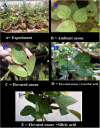Silicic and Ascorbic Acid Induced Modulations in Photosynthetic, Mineral Uptake, and Yield Attributes of Mung Bean (Vigna radiata L. Wilczek) under Ozone Stress
- PMID: 37091383
- PMCID: PMC10116534
- DOI: 10.1021/acsomega.3c00376
Silicic and Ascorbic Acid Induced Modulations in Photosynthetic, Mineral Uptake, and Yield Attributes of Mung Bean (Vigna radiata L. Wilczek) under Ozone Stress
Abstract
Most of the world's crop production and plant growth are anticipated to be seriously threatened by the increasing tropospheric ozone (O3) levels. The current study demonstrates how different mung bean genotypes reacted to the elevated level of O3 in the presence of exogenous ascorbic and silicic acid treatments. It is the first report to outline the potential protective effects of ascorbic and silicic acid applications against O3 toxicity in 12 mung bean {Vigna radiata (L.) Wilken} varieties. Under controlled circumstances, the present investigation was conducted in a glass house. There were four different treatments used: control (ambient O3 concentration of 40-45 ppb), elevated O3 (120 ppb), elevated O3 with silicic acid (0.1 mM), and elevated O3 with ascorbic acid (10 mM). Three varieties, viz. NM 20-21, NM 2006, and NM 2016, showcased tolerance to O3 toxicity. Our findings showed that ascorbic and silicic acid applications gradually increased yield characteristics such as seed yield, harvest index, days to maturity, and characteristics related to gas exchange such as transpiration rate, stomatal conductance, net photosynthetic activity, and water-use efficiency. Compared to the control, applying both growth regulators enhanced the mineral uptake across all treatments. Based on the findings of the current study, it is concluded that the subject mung bean genotypes responded to silicic acid treatment more efficiently than ascorbic acid to mitigate the harmful effects of O3 stress.
© 2023 The Authors. Published by American Chemical Society.
Conflict of interest statement
The authors declare no competing financial interest.
Figures




Similar articles
-
Elevated ozone phytotoxicity ameliorations in mung bean {Vigna radiata (L.) Wilczek} by foliar nebulization of silicic acid and ascorbic acid.Environ Sci Pollut Res Int. 2022 Oct;29(46):69680-69690. doi: 10.1007/s11356-022-20549-8. Epub 2022 May 16. Environ Sci Pollut Res Int. 2022. PMID: 35576036
-
Ascorbic and silicic acid application mitigated toxic effects of ozone in mung bean (Vigna radiata L. Wilczek) by modulating growth, secondary metabolites, water relations, and grain quality attributes.J Sci Food Agric. 2025 Jun;105(8):4400-4411. doi: 10.1002/jsfa.14185. Epub 2025 Feb 19. J Sci Food Agric. 2025. PMID: 39968605 Free PMC article.
-
Ozone-induced oxidative stress alleviation by biogenic silver nanoparticles and ethylenediurea in mung bean (Vigna radiata L.) under high ambient ozone.Environ Sci Pollut Res Int. 2024 Apr;31(18):26997-27013. doi: 10.1007/s11356-024-32917-7. Epub 2024 Mar 19. Environ Sci Pollut Res Int. 2024. PMID: 38503953
-
Effect of tropospheric ozone and its protectants on gas exchange parameters, antioxidant enzymes and quality of Garlic (Allium sativum. L).Int J Biometeorol. 2024 May;68(5):991-1004. doi: 10.1007/s00484-024-02642-4. Epub 2024 Mar 25. Int J Biometeorol. 2024. PMID: 38528211
-
Neuroprotective Potential of Mung Bean (Vigna radiata L.) Polyphenols in Alzheimer's Disease: A Review.J Agric Food Chem. 2021 Oct 6;69(39):11554-11571. doi: 10.1021/acs.jafc.1c04049. Epub 2021 Sep 22. J Agric Food Chem. 2021. PMID: 34551518 Review.
Cited by
-
Cucumber grafting on indigenous cucurbit landraces confers salt tolerance and improves fruit yield by enhancing morpho-physio-biochemical and ionic attributes.Sci Rep. 2023 Dec 7;13(1):21697. doi: 10.1038/s41598-023-48947-z. Sci Rep. 2023. PMID: 38066051 Free PMC article.
-
Biochar and Seed Priming Technique with Gallic Acid: An Approach toward Improving Morpho-Anatomical and Physiological Features of Solanum melongena L. under Induced NaCl and Boron Stresses.ACS Omega. 2023 Jul 26;8(31):28207-28232. doi: 10.1021/acsomega.3c01720. eCollection 2023 Aug 8. ACS Omega. 2023. PMID: 38173954 Free PMC article.
-
Morphoanatomical and Physiological Adaptations of Triticum aestivum L. against Allelopathic Extract of Trianthema portulacastrum L. (Horse purslane).ACS Omega. 2023 Sep 21;8(39):35874-35883. doi: 10.1021/acsomega.3c03238. eCollection 2023 Oct 3. ACS Omega. 2023. PMID: 37810676 Free PMC article.
-
Seed Priming Modulates Physiological and Agronomic Attributes of Maize (Zea mays L.) under Induced Polyethylene Glycol Osmotic Stress.ACS Omega. 2023 Jun 15;8(25):22788-22808. doi: 10.1021/acsomega.3c01715. eCollection 2023 Jun 27. ACS Omega. 2023. PMID: 37396236 Free PMC article.
-
Physiological and Germination Responses of Muskmelon (Cucumis melo L.) Seeds to Varying Osmotic Potentials and Cardinal Temperatures via a Hydrothermal Time Model.ACS Omega. 2023 Sep 7;8(37):33266-33279. doi: 10.1021/acsomega.3c01100. eCollection 2023 Sep 19. ACS Omega. 2023. PMID: 37744846 Free PMC article.
References
-
- Salam A.; Afridi M. S.; Javed M. A.; Saleem A.; Hafeez A.; Khan A. R.; Zeeshan M.; Ali B.; Azhar W.; Sumaira; et al. Nano-Priming against Abiotic Stress: A Way Forward towards Sustainable Agriculture. Sustainability 2022, 14, 14880.10.3390/su142214880. - DOI
-
- Neale R. E.; Barnes P. W.; Robson T. M.; Neale P. J.; Williamson C. E.; Zepp R. G.; Wilson S. R.; Madronich S.; Andrady A. L.; Heikkilä A. M.; et al. Environmental Effects of Stratospheric Ozone Depletion, UV Radiation, and Interactions with Climate Change: UNEP Environmental Effects Assessment Panel, Update 2020. Photochem. Photobiol. Sci. 2021, 20, 1–67. 10.1007/s43630-020-00001-x. - DOI - PMC - PubMed
-
- Juráň S.; Grace J.; Urban O. Temporal Changes in Ozone Concentrations and Their Impact on Vegetation. Atmosphere 2021, 12, 82.10.3390/atmos12010082. - DOI
LinkOut - more resources
Full Text Sources

